MWC Barcelona is the largest mobile connectivity event spanning the whole ecosystem including global mobile operators, device manufacturers, technology providers, vendors, and content owners. Typical attendance exceeds 100,000 with 8 halls of exhibition and conference. This year’s hot topics included 5G Advanced/6G, non-terrestrial networks (NTN), reduced capacity (Red Cap) 5G, Open Radio Access Network (RAN), WiFi 7, Private 5G networks, security and of course, AI. I visited the following companies and summarized their new products/offerings.
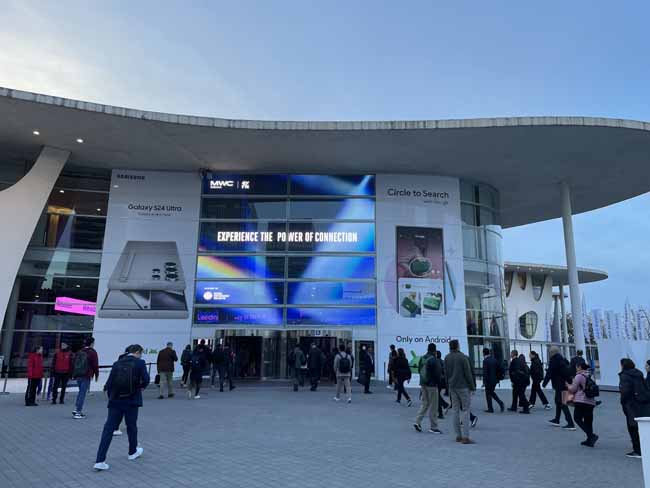
View our photo gallery here: https://www.microwavejournal.com/media/photos/128-mwc-2024-barcelona
Video our video demos here: https://videos.microwavejournal.com/mwjmenulist/336661812/Mobile+World+Congress+Barcelona
ALifecom hosted its Tech Day 2024 in January. Established in 2009, ALifecom is dedicated to advancing wireless communication technology. ALifecom possesses several fundamental patents and offers adaptable customized services. Alongside the expertise in 4G/5G mobile network testing, ALifecom has recently introduced and showcased IoT NTN and WiFi 7 measurement solutions during Tech Day 2024.
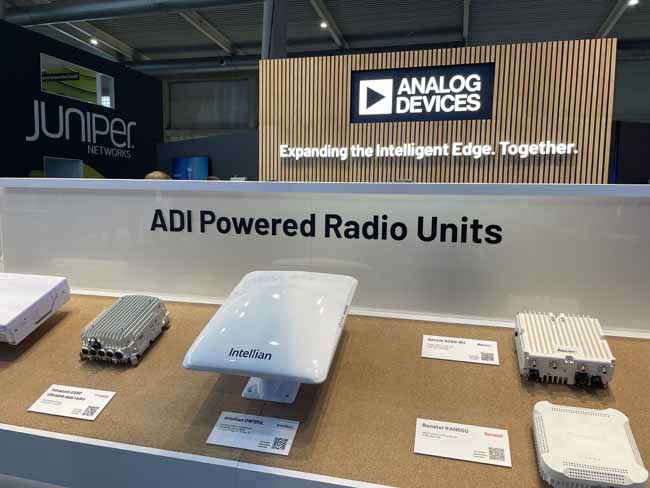 Analog Devices demonstrated an integrated 4G, 5G, WiFi plug and play small cell, complete with single chip multi-mode L1 Physical Layer and interoperable L2/L3 software stack from Blinq Networks and EdgeQ. Customers can leverage this converged solution, which can be upgraded over-the-air, to realize compelling unit economics - using up to 33% less energy. ADI showed how Delta Electronics is expanding the market for fixed wireless access across the globe with an on-premises, 26 GHz mmW radio unit. The compact product uses ADI’s latest generation mmW front-end solution to deliver a high performance, cost-effective system. In another kiosk, New Edge Signal Solutions leveraged ADI's 8T8R Open RAN Radio Unit Platform to win the top Mobility prize at the NTIA’s 5G Challenge, while simultaneously commercializing the design into a production ready solution for a major OEM customer within 12 months. Working with Vodafone, Analog Devices demonstrated energy savings using embedded features in ADI's RadioVerse® Transceiver SoC. By capturing micro-second gaps in transmissions, the ADRV904x can reduce RU energy consumption by more than 40%, without incremental technology or expense.
Analog Devices demonstrated an integrated 4G, 5G, WiFi plug and play small cell, complete with single chip multi-mode L1 Physical Layer and interoperable L2/L3 software stack from Blinq Networks and EdgeQ. Customers can leverage this converged solution, which can be upgraded over-the-air, to realize compelling unit economics - using up to 33% less energy. ADI showed how Delta Electronics is expanding the market for fixed wireless access across the globe with an on-premises, 26 GHz mmW radio unit. The compact product uses ADI’s latest generation mmW front-end solution to deliver a high performance, cost-effective system. In another kiosk, New Edge Signal Solutions leveraged ADI's 8T8R Open RAN Radio Unit Platform to win the top Mobility prize at the NTIA’s 5G Challenge, while simultaneously commercializing the design into a production ready solution for a major OEM customer within 12 months. Working with Vodafone, Analog Devices demonstrated energy savings using embedded features in ADI's RadioVerse® Transceiver SoC. By capturing micro-second gaps in transmissions, the ADRV904x can reduce RU energy consumption by more than 40%, without incremental technology or expense.
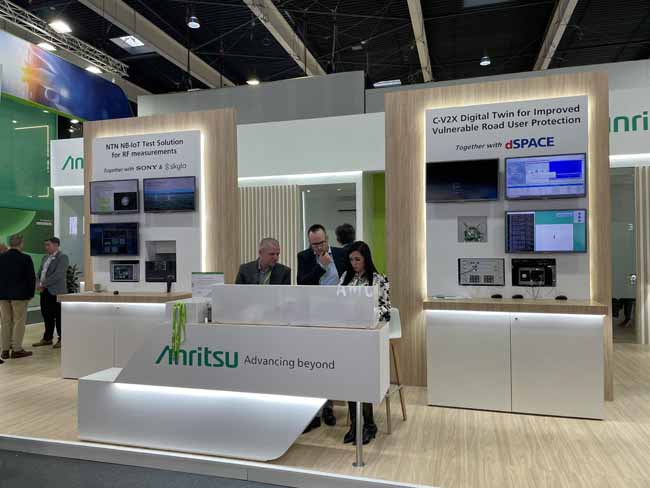 Anritsu Corporation highlighted an AI-powered RF sensing tool, an advanced digital twin simulation environment for C-V2X, NTN device measurements, and Field-to-lab Simulation Test. The company will also share findings from its research programs evaluating the test methodologies and functional architecture for 6G. The RF sensing tool, based on AI, provides a new class of RF sensing built on Anritsu Spectrum Analyzer and DeepSig software. Going beyond the capabilities of existing spectrum monitoring solutions, DeepSig software presents an AI-assisted system that detects and classifies signals, and simultaneously understands the spectrum environment to inform contextual analysis and decision-making. Anritsu also highlighted the evolution of Service Assurance into a core component vital for ensuring high performance and reliability in the dynamic networks of the future, complemented by a demo showcasing GenAI's role in this transformation. Emphasizing the shift to cloud native networks, Anritsu offers innovative solutions for operational efficiency and seamless future network integration. Anritsu also be presented an advanced digital twin simulation environment designed to provide improved protection for vulnerable road users (VRU) that Anritsu developed in cooperation with dSpace. The event will see a demonstration of a road safety use case using the C-V2X network for cooperative communications. Because NTN uses satellite, this creates challenges with propagation delay and low signal levels, resulting in a demanding RF environment. Anritsu’s solution, displayed with the collaboration of Sony Semiconductor Israel and Skylo Technologies, enables customers to test RF parametric with call connection in NTN environment. In 5G a UE is required to support increasingly complex network configurations and support many frequency band combinations. However, when it comes to device performance and stability, it is difficult to verify the countless field conditions using only 3GPP defined test conditions. The FST solution helps to ensure stable performance of devices and modems in mobile networks by providing a unique solution to replicate field testing into the lab. The demonstration showed how to improve test development efficiency via automation, and the quality of user equipment by re-creating multiple test scenarios with closer to real network situations. Energy efficiency and battery life are two consumer led key characteristics that will be addressed in new EU regulations for labelling of smartphones and tablets. A complete solution for testing and declaration of energy classes was shown in collaboration with SmartViser.
Anritsu Corporation highlighted an AI-powered RF sensing tool, an advanced digital twin simulation environment for C-V2X, NTN device measurements, and Field-to-lab Simulation Test. The company will also share findings from its research programs evaluating the test methodologies and functional architecture for 6G. The RF sensing tool, based on AI, provides a new class of RF sensing built on Anritsu Spectrum Analyzer and DeepSig software. Going beyond the capabilities of existing spectrum monitoring solutions, DeepSig software presents an AI-assisted system that detects and classifies signals, and simultaneously understands the spectrum environment to inform contextual analysis and decision-making. Anritsu also highlighted the evolution of Service Assurance into a core component vital for ensuring high performance and reliability in the dynamic networks of the future, complemented by a demo showcasing GenAI's role in this transformation. Emphasizing the shift to cloud native networks, Anritsu offers innovative solutions for operational efficiency and seamless future network integration. Anritsu also be presented an advanced digital twin simulation environment designed to provide improved protection for vulnerable road users (VRU) that Anritsu developed in cooperation with dSpace. The event will see a demonstration of a road safety use case using the C-V2X network for cooperative communications. Because NTN uses satellite, this creates challenges with propagation delay and low signal levels, resulting in a demanding RF environment. Anritsu’s solution, displayed with the collaboration of Sony Semiconductor Israel and Skylo Technologies, enables customers to test RF parametric with call connection in NTN environment. In 5G a UE is required to support increasingly complex network configurations and support many frequency band combinations. However, when it comes to device performance and stability, it is difficult to verify the countless field conditions using only 3GPP defined test conditions. The FST solution helps to ensure stable performance of devices and modems in mobile networks by providing a unique solution to replicate field testing into the lab. The demonstration showed how to improve test development efficiency via automation, and the quality of user equipment by re-creating multiple test scenarios with closer to real network situations. Energy efficiency and battery life are two consumer led key characteristics that will be addressed in new EU regulations for labelling of smartphones and tablets. A complete solution for testing and declaration of energy classes was shown in collaboration with SmartViser.
Ataya recently published a blog on Microwave Journal on Private 5G Networks. Private 5G is the perfect solution for enterprises seeking to achieve reliable low latency, expand coverage, or deliver Gbps throughput for their mission-critical applications and varied use cases. The use cases are driving current and new players in the market to make a mark and provide the best private 5G network to industries and enterprises ranging from small to large-scale deployments. However, the industry is falling behind its forecasts when it comes to converting these use cases to commercial deployments. One of the barriers that remains is the complexity of deploying Private 5G. Check out their blog here.
CHASM Advanced Materials announced a major scale-up in the production of customized transparent antennas based on its AgeNT® transparent antenna technology, following successful market introduction last year. This expansion is in response to growing global demand and CHASM’s commitment to innovation in connectivity technologies. The production expansion is bolstered by CHASM’s strategic partnership with Kundisch/Phoenix Mecano, a leader in precision fabrication of printed electronics devices. This collaboration ensures that the increased output maintains the quality and efficiency that CHASM is known for as a leader in transparent antenna technology. The AgeNT® transparent antenna solution, utilizing cutting-edge carbon nanotube/copper micromesh technology, offers efficacy on par with low-loss, ceramic PCB-based antenna options. Its over 90% optical transparency combined with high performance redefines wireless communication, blending seamlessly into various applications.
 Ericsson announced extensive enhancements to its radio, transport and antenna portfolio with 12 new hardware and software solutions for communications service providers (CSPs) to deploy in high-performing, sustainable and open networks. Unveiled at the company’s pre-Mobile World Congress 2024 event in London, the portfolio enhancements are led by the flagship product AIR 3255, a Massive MIMO TDD radio with more than 25 percent energy savings and 20 percent lower embodied carbon footprint* compared to the previous generation radio. The following new radios join AIR 3255 in boosting Ericsson’s radio line-up:
Ericsson announced extensive enhancements to its radio, transport and antenna portfolio with 12 new hardware and software solutions for communications service providers (CSPs) to deploy in high-performing, sustainable and open networks. Unveiled at the company’s pre-Mobile World Congress 2024 event in London, the portfolio enhancements are led by the flagship product AIR 3255, a Massive MIMO TDD radio with more than 25 percent energy savings and 20 percent lower embodied carbon footprint* compared to the previous generation radio. The following new radios join AIR 3255 in boosting Ericsson’s radio line-up:
• Triple-band Massive MIMO FDD radio AIR 3284 (32T/32R) providing 2x higher downlink and 4x higher uplink capacity** compared to 4T/4R.
• Radio 4823 (4T/8R), boosting uplink performance (2x) with separate remote electrical tilt on the 2.6GHz frequency band to extend coverage or capacity based on the deployment choice.
• AIR 5343 for high-capacity and high-performing Fixed Wireless Access with macro deployment. Up to 1600 MHz total carrier bandwidth and 11 dB extended coverage.
Ultralight mid-band TDD radios
• Radio 4461HP (high-power) with 50 percent more output power and 42 percent lower embodied carbon footprint and Radio 8873 in both standard power and high-power (HP) variants
And to complete the portfolio enhancements, Ericsson is introducing next-generation transport and antenna solutions:
• MINI-LINK 6355 – improved E-band performance with next-gen, all-outdoor E-band node. The 2x output power and 25GE interfaces extend hop-length and capacity in multi-carrier configurations. Added Radio Deep Sleep energy-saving feature for E-band.
• Antenna 4206 – two low-band, four mid-band; 2.1m based on new antenna structure. Latest Ericsson Antenna System high-performing solution with up to 85 percent beam efficiency and 49 percent savings in embodied carbon footprint and 24 percent less weight, using 100 percent thermoplastic radome and lighter build. Fully recyclable.
Finwave Semiconductor showcased its advanced GaN-on-Si technology and HP switches targeting the infrastructure and handset markets. Finwave reviewed its enhancement-mode 200mm GaN-on-Si transistor technology. Differentiated from conventional depletion-mode GaN technology, Finwave’s Emode RF FETs have less than 1 ohm-mm on-resistance, low-knee voltage, > 700 mS/mm transconductance and negligible current collapse with PAE as high as 60% and excellent AM-PM performance for operating frequency ranging from 8 to 26 GHz. The technology is capable of operating at Vdd of 5V or lower, demonstrating its potential for efficient power amplifiers for 6G FR3 frequency band (7-24 GHz) and FR2 mmWave band infrastructure, CPEs and handset applications. They also discussed their 3DGaN FinFET technology demonstrating excellent linearity improvement capability. Due to its three-dimensional gate geometry, Finwave’s 3DGaN FinFET reduces transistor leakage current, current collapse and knee voltage while improving PAE and linearity over 10 dB compared to conventional GaN transistors. With higher linearity, better PAE and reduced memory effect, 3DGaN FinFET technology is attractive for applications such as massive MIMO with large arrays. Finwave also unveiled its first family of HP RF switch products. The RF switch products feature 100 ns fast switching and settling time, broadband operations up to 12 GHz and HP handling up to 40 W.
Fujikura has commercialized a Phased Array Antenna Module for 5G millimeter communications operated on the 3GPP frequency bands: n257 (28 GHz), n258 (26 GHz), and n261 (27 GHz). The Fujikura PAAM is equipped with proprietary RF-ICs developed-in-house. This module is a highly integrated module with beamforming IC, frequency converter IC, array antenna and filter. Fujikura has designed all the components in-house and has been optimizing the performance of the module. The module can support tens of thousands of beams with quick beam switching and provides calibration-free precise beam scanning. The module is mainly developed for infrastructure purpose and is suitable for various applications such as mobile network access and fixed wireless access. Fujikura and Avnet have released a PAAM development platform for mmWave frequency bands. This platform enables customers to develop advanced 5G mmWave systems using Fujikura’s PAAM and AMD’s Zynq™ RFSoC* Gen3, controlled by Avnet’s proven RFSoC Explorer® software. This combination of leading-edge components and software will allow customers to prototype quickly with Fujikura’s compact PAAM and AMD’s RFSoC. Avnet's RFSoC Explorer® software, included with the development platform, is scalable to control the entire system from the antenna to digital and is an easy to use MATLAB application that allows you to quickly implement and test beamforming applications without HDL* or software coding.
I meet with Gamgee that is bringing new, easy to use services to Wi-Fi networks. Their platform extends Wi-Fi to assure devices always use the best available Wi-Fi connection and time-sensitive applications are prioritized. It can detect presence and motion for security to improve home safety plus Wi-Fi sensing enhances smart home features, and MAC de-randomization reliably identifies devices. It can enhance protection with anomaly detection and keep browsing secure. It can suggest services driven by interest and usage patterns and facilitate their discovery with complimentary and trial options plus gives users access to all features, from anywhere, with their mobile app. They can manage network settings, boost or pause devices, establish a guest network, and run performance scans. he app is customizable with your brand and languages, fitting your business perfectly. And it works with any hardware so look to see this deployed in the future.
 Greenerwave unveiled the version 2.0 of its reconfigurable intelligent surfaces (RIS). Based on a cheaper and far more energy-efficient new component, this version promises a ten-fold reduction in energy consumption and drastically lower costs compared with RIS 1.0. This new generation of RIS will soon give operators access to an agnostic, more cost-effective and energy-efficient solution allowing them to optimize their network quality without having to deploy multiple antennas. For users, it will guarantee a steady broadband connection even in the densest areas. Greenerwave’s RIS 2.0 is the green and affordable solution for mobile telecom operators. Greenerwave designs metasurfaces comprising elements that “shape” electromagnetic, enabling directional beams to be generated and controlled. These metasurfaces consist of a group of elements of centimetric size called pixels that act as micromirrors. Each pixel can modify the sign of the reflected wave. The interactions between pixels and microwaves are managed by algorithms derived from the world of physics that direct waves after their reflection on the surface.
Greenerwave unveiled the version 2.0 of its reconfigurable intelligent surfaces (RIS). Based on a cheaper and far more energy-efficient new component, this version promises a ten-fold reduction in energy consumption and drastically lower costs compared with RIS 1.0. This new generation of RIS will soon give operators access to an agnostic, more cost-effective and energy-efficient solution allowing them to optimize their network quality without having to deploy multiple antennas. For users, it will guarantee a steady broadband connection even in the densest areas. Greenerwave’s RIS 2.0 is the green and affordable solution for mobile telecom operators. Greenerwave designs metasurfaces comprising elements that “shape” electromagnetic, enabling directional beams to be generated and controlled. These metasurfaces consist of a group of elements of centimetric size called pixels that act as micromirrors. Each pixel can modify the sign of the reflected wave. The interactions between pixels and microwaves are managed by algorithms derived from the world of physics that direct waves after their reflection on the surface.
Huawei officially launched ten industrial digital and intelligent transformation solutions and a series of new flagship products including National Cloud Solution 2.0, Smart City, Smart Classroom 3.0, Medical Technology Digitalization, Digital CORE, Intelligent Factory, Smart Airport Fully Connected Fiber Network, Perimeter Security with Fiber Sensing, Smart Railway Perimeter Detection, ITS 2.0, Intelligent Power Distribution (IDS), Oil and Gas Pipeline Safety Management Solutions. In addition, Huawei released several product portfolios, including the Campus Digital Platform, Multilayer Ransomware Protection (MRP) 2.0, and Perimeter Protection Site. They won a bunch of awards from MWC dominating many categories.
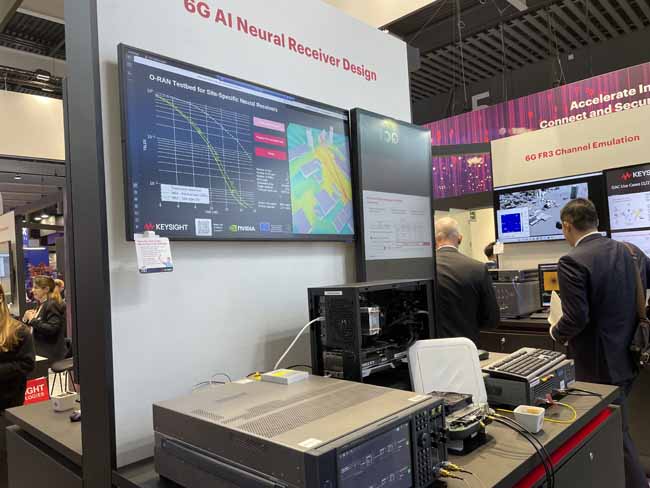 Keysight had a lot of demos including Advanced NTNs with Qualcomm Technologies that provide a glimpse into Release 18 5G-Advanced mobility featuring complex low-Earth-orbit, high-velocity Doppler test scenarios with multiple satellites. This joint demo covered video calls with the support of satellite handovers (NTN-NTN) to ensure service continuity and seamless integration with terrestrial networks using a 5G mobile test platform from Qualcomm Technologies. The demo showcased the Keysight end-to-end NTN solution portfolio, spanning R&D and acceptance workflows for New Radio (NR) and Narrowband Internet of Things (NB-IoT NTN) and featured three use cases showing how to build reliable 5G NTN’s, Long Term Evolution NTN unmodified direct-to-cell handsets, and operator acceptance.
Keysight had a lot of demos including Advanced NTNs with Qualcomm Technologies that provide a glimpse into Release 18 5G-Advanced mobility featuring complex low-Earth-orbit, high-velocity Doppler test scenarios with multiple satellites. This joint demo covered video calls with the support of satellite handovers (NTN-NTN) to ensure service continuity and seamless integration with terrestrial networks using a 5G mobile test platform from Qualcomm Technologies. The demo showcased the Keysight end-to-end NTN solution portfolio, spanning R&D and acceptance workflows for New Radio (NR) and Narrowband Internet of Things (NB-IoT NTN) and featured three use cases showing how to build reliable 5G NTN’s, Long Term Evolution NTN unmodified direct-to-cell handsets, and operator acceptance.
Current WiFi networks are being stretched, and it is crucial to test new stations and access points to validate RF performance, scheduling choices, and optimization. The Keysight UXM Wireless Connectivity Test Platform supports both WiFi 7 and 5G. Keysight’s Eggplant automation software will also be showcased, which uses ML and automation intelligence with a synthetic human, achieving fully robotic and repeatable test automation of new WiFi and 5G XR devices.
As the deployment of Open RAN networks increases, new challenges and opportunities emerge. Keysight showcased three demos that addressed energy consumption by highlighting how to maximize network performance with AI/ML, reduce energy consumption, secure the network and increase its resilience.
Keysight’s new AI-assisted radio channel emulation solutions accelerate the development and evaluation of complex 6G technologies. This demo showed how to address accurate modeling needs in 6G system simulations, digital twins, and real time RF channel emulation. Another demo was part of the latest research from the European Horizon project, CENTRIC. A neural receiver provided by NVIDIA is validated in an Open RAN testbed using data generated from Keysight PathWave SystemVue. This enables the design of a neural receiver using AI for 6G networks and how data can serve as a digital twin of a channel to compare simulation results with a real-world system. Keysight also showcased how to use its Electronic Design Automation (EDA) software in technology research. This demo integrated AI / ML signal processing models and verifies the performance of the algorithms with a real hardware connection in an over-the-air (OTA) system.
 Narda Safety Test Solutions has developed two new 5G antennas for its SRM-3006 that enable this tried and tested handheld field strength measuring system to measure the upper 5G frequency band FR2. One omnidirectional and one directional downconverter antenna will now capture electromagnetic fields and their sources in the range between 24.25 and 29.50 GHz. Both antennas can downconvert these high 5G frequencies so that they can be measured by the Narda Selective Radiation Meter. This means that the results for frequencies much higher than the specified device range are conveniently shown directly on the display referred to the permitted limit value for the actual frequency. Narda has opened the door to the future of electromagnetic field measurements with the FieldMan. The instrument is handy, intuitive, easy to use instrument with its various digital probes is all that is needed for reliable isotropic field measurements from DC up to an unrivalled 90 GHz. Its precise, reproducible measurements will deliver meaningful and authoritative results even for future applications in the fields of health and safety at work and in the environment. The successful SignalShark family from Narda Safety Test Solutions now has support in handling the many challenges involved in effective radio monitoring and direction finding of interference signals. The weatherproof SignalShark Outdoor Unit will from now on primarily take on the job of 24/7 radio monitoring. Even under the most adverse conditions, it delivers precise, eliable signal detection and localization results, and operates completely autonomously thanks to its Power over Ethernet or solar panel supply. Equipped with the same measuring core and good DNA as its two older siblings, the Handheld and the Remote Unit, it too receives and analyzes radio signals at up to 8 GHz. With its real time bandwidth of 40 MHz, the Outdoor Unit is capable of broadband signal capture despite its compact size – highly sensitive, ITU compliant. Narda Safety Test Solutions also extended the spectrum of applications for its SignalShark with functions for broadband mobile signal monitoring and real time analysis. The precursor to this development was the decision made by the RF measurement technology specialist to collaborate with PROCITEC. The aim of this wholly German technology partnership was to create a perfect mobile monitoring and real time analysis system for land, sea, and air-based wireless communication systems.
Narda Safety Test Solutions has developed two new 5G antennas for its SRM-3006 that enable this tried and tested handheld field strength measuring system to measure the upper 5G frequency band FR2. One omnidirectional and one directional downconverter antenna will now capture electromagnetic fields and their sources in the range between 24.25 and 29.50 GHz. Both antennas can downconvert these high 5G frequencies so that they can be measured by the Narda Selective Radiation Meter. This means that the results for frequencies much higher than the specified device range are conveniently shown directly on the display referred to the permitted limit value for the actual frequency. Narda has opened the door to the future of electromagnetic field measurements with the FieldMan. The instrument is handy, intuitive, easy to use instrument with its various digital probes is all that is needed for reliable isotropic field measurements from DC up to an unrivalled 90 GHz. Its precise, reproducible measurements will deliver meaningful and authoritative results even for future applications in the fields of health and safety at work and in the environment. The successful SignalShark family from Narda Safety Test Solutions now has support in handling the many challenges involved in effective radio monitoring and direction finding of interference signals. The weatherproof SignalShark Outdoor Unit will from now on primarily take on the job of 24/7 radio monitoring. Even under the most adverse conditions, it delivers precise, eliable signal detection and localization results, and operates completely autonomously thanks to its Power over Ethernet or solar panel supply. Equipped with the same measuring core and good DNA as its two older siblings, the Handheld and the Remote Unit, it too receives and analyzes radio signals at up to 8 GHz. With its real time bandwidth of 40 MHz, the Outdoor Unit is capable of broadband signal capture despite its compact size – highly sensitive, ITU compliant. Narda Safety Test Solutions also extended the spectrum of applications for its SignalShark with functions for broadband mobile signal monitoring and real time analysis. The precursor to this development was the decision made by the RF measurement technology specialist to collaborate with PROCITEC. The aim of this wholly German technology partnership was to create a perfect mobile monitoring and real time analysis system for land, sea, and air-based wireless communication systems.
Nokia announced that it was selected by Rakuten Mobile to supply RAN solutions from its energy-efficient AirScale portfolio supporting the low 700 MHz spectrum band. The move will see Rakuten Mobile deliver enhanced coverage, capacity, and network performance to its customers across its end-to-end fully virtualized, cloud native OpenRAN mobile network in Japan.
Nokia also announced a new 5G outdoor fixed wireless access receiver designed to enhance broadband coverage for urban, suburban, and rural areas. The outdoor receiver allows operators to use low-cost mmWave spectrum to provide consistent, reliable, ultra-fast wireless broadband services in areas where fiber can be challenging to deploy. Mounted on a balcony, wall, or pole, the outdoor receiver uses unique 360-degree field-of-view technology and Nokia Bell Labs advanced algorithms to enhance performance. With the ability to create a digital fingerprint of available radio signals, it can identify changes and rapidly switch between signal sources to ensure the best possible connection is maintained between the base station and receiver. This, along with the use of high gain antennas (up to 27 dBi) creates the first mmWave Fixed Wireless Access (FWA) solution that works in non-Line-of-Sight conditions, is easy to install by the customer and, allows operators to avoid costly track-rolls.
pSemi Corporation announced the PE44951, a low-power, two-way phase shifter with digitally controlled step attenuation (DSA) for applications within the 5.925 to 7.525 GHz range. pSemi showcased its latest products for IoT connectivity, including the recently announced PE562212 front-end module and the PE423211 SPDT switch, an automotive UWB solution. The PE44951 marks a significant advancement in the industry, as the 6.425 to 7.125 GHz (n104) spectrum becomes available. The solution is the first highly integrated two-way phase shifter with DSA in the 5.925 to 7.525 GHz range to enable hybrid beamforming. This product well suited in wireless infrastructure applications like massive MIMO (mMIMO) macro and micro base stations, as well as next-generation 5G solutions. The solution combines a two-way phase shifter and DSA in a single compact package. Minimizing board space and simplifying system integration, this innovative design streamlines the development process. Moreover, its SPI interface achieves precise and flexible control, reducing power consumption and ensuring seamless system integration.
Qualcomm is driving wireless innovations on all fronts. From improving the efficiency of 5G systems in existing sub-7 GHz and mmWave bands to pioneering groundbreaking solutions for 6G, our advanced research serves as the bedrock for what lies ahead. Some highlights were: their “Giga-MIMO” system with 4096 antenna elements at 13 GHz in the base station, but comparable in size to the 5G massive MIMO which is the first Giga-MIMO antenna prototype to operate in the 13 GHz band and only working FR3 demo I saw; hybrid beamforming mmWave demo that included simple and network-controlled repeaters, wireless access and backhaul, as well as reconfigurable intelligent surfaces that can be used to extend network coverage across different settings and use cases; AI demos including a collaboration with Nokia Bell Labs, showcasing how sequential learning can enable a multi-vendor wireless AI system and second demo extending their in-house prototype of AI-enabled mmWave beam management, now also supporting spatial-domain beam prediction; and they showcased practical implementations of point-to-multipoint communications with new spectrum in the 140 GHz band and dynamically reconfigurable point-to-point wireless links in the data center. They had many other demos in the area of automotive and VR/XR plus in other booths around the event.
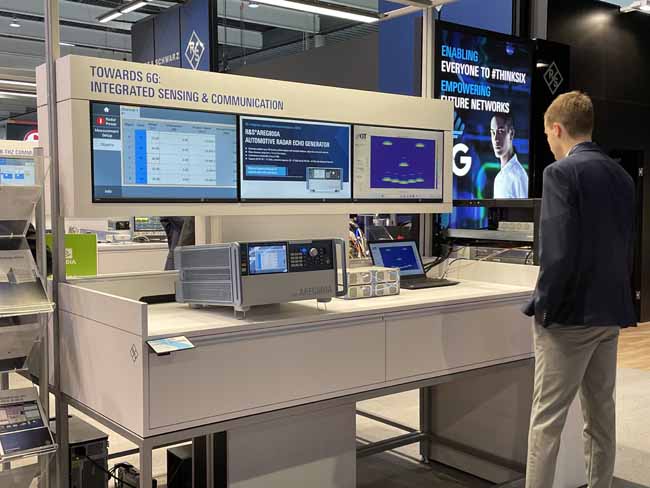 Rohde & Schwarz featured a live 5G NTN-NR connection, emulating a LEO satellite access node. The R&S CMX500 OBT radio communication tester simulated the satellite base station in combination with the R&S SMBV100B vector signal generator, which simulates the different satellite constellations with its integrated GNSS option. The R&S CMX500 operates in an interactive callbox mode, allowing users to trigger voice calls alongside RF-related measurements. This test mode highlights the tester’s versatility in evaluating both the performance and reliability of 5G connections under different conditions to ensure that future NTN-NR devices powered by MediaTek’s NTN test platform will work anywhere in the world.
Rohde & Schwarz featured a live 5G NTN-NR connection, emulating a LEO satellite access node. The R&S CMX500 OBT radio communication tester simulated the satellite base station in combination with the R&S SMBV100B vector signal generator, which simulates the different satellite constellations with its integrated GNSS option. The R&S CMX500 operates in an interactive callbox mode, allowing users to trigger voice calls alongside RF-related measurements. This test mode highlights the tester’s versatility in evaluating both the performance and reliability of 5G connections under different conditions to ensure that future NTN-NR devices powered by MediaTek’s NTN test platform will work anywhere in the world.
The R&S TS8980 is an official 5G conformance test platform approved by the Global Certification Forum and the PCS Type Certification Review Board. Rohde & Schwarz has developed two new setups for its successful R&S TS8980 family: the R&S TS8980S-4A and the R&S TS8980FTA-3A. These solutions meet the market requirements for reduced hardware and a smaller footprint. The single-box solution R&S TS8980S-4A is a fully automated conformance test system for performing validated conformance test cases up to 8 GHz and 4 carrier aggregation (4 CA). The single-rack solution R&S TS8980FTA-3A is the most compact conformance test solution on the market. It supports the full range of both inband and out-of-band test cases and the entire device certification process for RF and RRM, covering 5G NR as defined by 3GPP and carrier acceptance specifications.
The Rohde & Schwarz NTN Netop test solutions have been accepted as part of the NTN Certification Program of Skylo, a pioneer in NTN. The Netop product now has a suite of 64 validated test cases that address the unique challenges of satellite communication, including variable orbital dynamics and the resulting Doppler shifts and delays. The test cases cover a variety of orbit scenarios, including GEO with variable delay and Doppler effects, in different SINR conditions. The Netop test suite meets the stringent requirements of the Skylo test plan, ensuring that chipset, module, and device manufacturers can seamlessly validate their products for Skylo's NTN.
Sivers Semiconductors presented Module BFM02803 that is optimized for high performance, HP FWA applications and enables to differentiate and meet the requirements of large-scale manufacturing of FWA products. It is designed to interface with leading baseband modems. It supports 2×2 MIMO with dual-layer polarization in both downlink and uplink for channels up to 1.2 GHz. The new module includes 32 dual-polarized antenna elements with 2D beam steering capabilities, in azimuth and elevation. Autonomous calibration routines and simple baseband interfaces make the module easy to install and manage. With the use of an air-filled cavity in the PCB, the module is optimized for large-scale, low-loss, and low-cost assembly. Additionally, transmitted power greater than +50 dBm per polarization enables FWA product deployments in the most diverse applications with the lowest total cost of ownership.
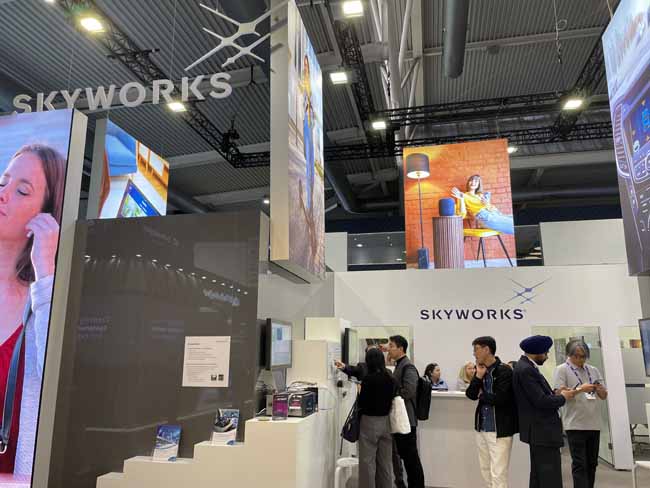 Skyworks Solution and Samsung Electronics announced a strategic partnership to deliver SKY5® transceiver-to-antenna Radio Frequency Front-End (RFFE) total solutions for the next-generation of 5G modem platforms. Designed to enable seamless integration of 5G connectivity across multiple frequency bands and modes, while optimizing performance, power efficiency and design flexibility, this complete end-to-end solution supports the diverse requirements of 5G applications, such as enhanced mobile broadband, ultra-reliable low-latency communications and massive machine-type communications. Skyworks’ next-generation PA technology enables mass production and delivery of best-in-class low-band, mid-band, high band and ultra-high band APT (average power tracking) 5G system efficiency for global cellphones. This technology leverages advanced design and fabrication techniques to achieve superior performance, reliability and cost-effectiveness. This next-generation PA technology from Skyworks is compatible with all major 5G standards and bands and supports dynamic power management and adaptive modulation schemes. Skyworks' bulk acoustic wave (BAW) 2.0 technology enhances the transmit and receive capabilities of mobile devices across multiple frequency bands. It allows for seamless integration of carrier aggregation, which improves network performance and user experience.
Skyworks Solution and Samsung Electronics announced a strategic partnership to deliver SKY5® transceiver-to-antenna Radio Frequency Front-End (RFFE) total solutions for the next-generation of 5G modem platforms. Designed to enable seamless integration of 5G connectivity across multiple frequency bands and modes, while optimizing performance, power efficiency and design flexibility, this complete end-to-end solution supports the diverse requirements of 5G applications, such as enhanced mobile broadband, ultra-reliable low-latency communications and massive machine-type communications. Skyworks’ next-generation PA technology enables mass production and delivery of best-in-class low-band, mid-band, high band and ultra-high band APT (average power tracking) 5G system efficiency for global cellphones. This technology leverages advanced design and fabrication techniques to achieve superior performance, reliability and cost-effectiveness. This next-generation PA technology from Skyworks is compatible with all major 5G standards and bands and supports dynamic power management and adaptive modulation schemes. Skyworks' bulk acoustic wave (BAW) 2.0 technology enhances the transmit and receive capabilities of mobile devices across multiple frequency bands. It allows for seamless integration of carrier aggregation, which improves network performance and user experience.
Spirent Communications announced the industry’s first high-density test solution capable of emulating realistic AI workloads over Ethernet. As the networking world’s technology of choice, Ethernet is the backbone of the Cloud and the ability to emulate realistic AI traffic workloads and test their impact on AI data center networks and interconnects is key. Communications networks worldwide rely on Ethernet technology, and testing how the Ethernet fabric of new AI environments performs has proved to be an enormous challenge. AI training brings unique requirements, with dramatically increased workload volumes, high sensitivity to latency, congestion, and job completion times. Shortly after the event, VIAVI announced they plan to acquire Spirent.

